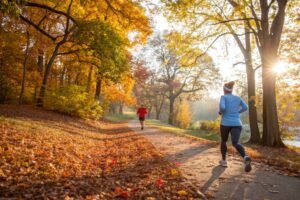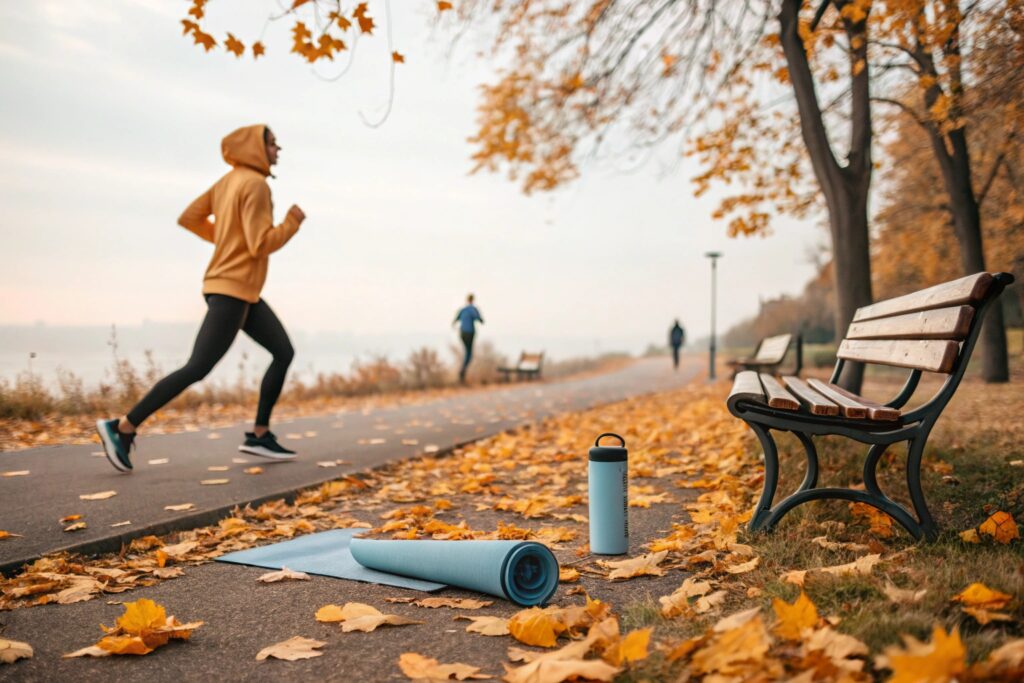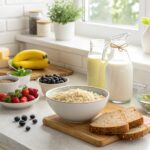Fall Fitness Kickstart: Your Plan for Cozy Season Gains
Introduction
As the leaves turn gold and the air grows crisp, many of us trade tank tops for sweaters and outdoor barbecues for pumpkin spice lattes. That seasonal shift can feel like a natural pause button on our workout routine, but it doesn’t have to be. The Fall Fitness Kickstart: Your Plan for Cozy Season Gains is a strategic, science‑backed roadmap that helps you harness the unique energy of autumn for stronger muscles, steadier metabolism, and a resilient immune system. In the paragraphs that follow, you’ll discover why fall is actually an optimal time to reset your fitness habits, how to design a balanced program that fits both indoor comfort and brisk outdoor sessions, and the exact steps you can take today to turn the cooler months into your most powerful training period yet.
Section 2 – Why Autumn Is the Ideal Time for a Fitness Reset
The physiological edge of cooler weather
Research from the American College of Sports Medicine (ACSM) shows that exercising in moderate, cool temperatures (50‑65°F/10‑18°C) improves oxygen uptake and reduces perceived exertion by up to 15 % compared with hot summer conditions. The body doesn’t have to work as hard to dissipate heat, allowing you to push harder during cardio or strength work while preserving glycogen stores. This physiological advantage translates to longer, more productive sessions—perfect for building “cozy season gains” without the burnout that often accompanies summer heat.
Psychological motivation and habit formation
Fall also delivers a psychological reset. A 2022 study in Health Psychology found that seasonal cues—like shorter daylight hours and the return of routine after vacation—trigger a 30 % increase in goal‑setting behavior. By aligning your fitness objectives with the symbolic theme of “harvest,” you create an emotional narrative that sustains motivation. In practice, this means framing each workout as a “seed” you’re planting for a stronger, healthier autumn and winter, rather than a chore you’re forced to endure.
Section 3 – Building a Balanced Autumn Workout Blueprint
1. Prioritize compound movements for efficient strength gains
Compound lifts such as squats, deadlifts, push‑ups, and rows recruit multiple muscle groups simultaneously, delivering a higher caloric burn and stronger hormonal response (testosterone and growth hormone spikes of 10‑20 %). For a cozy‑season plan, schedule three full‑body strength sessions per week, each centered around a primary compound lift followed by two accessory exercises (e.g., Bulgarian split squat, single‑arm dumbbell press).
Expert tip: Certified Strength & Conditioning Specialist (CSCS) Emily Rivera recommends a “reverse pyramid” approach in cooler months—starting with a heavy set of 4‑6 reps, then dropping the weight and increasing reps to 10‑12. This method maximizes muscle tension while keeping the session lively and adaptable to fluctuating energy levels.
2. Integrate low‑impact cardio that embraces the season

Autumn foliage offers a natural, scenic backdrop for low‑impact cardiovascular activities like brisk walking, trail running, or even Nordic skiing in snowy regions. Studies published in Journal of Sports Sciences indicate that moderate‑intensity cardio (60‑70 % of max HR) performed three times weekly improves insulin sensitivity by 23 %, a vital factor as daylight dwindles and metabolic rates tend to slow.
Practical example: Set a weekly “Leaf‑Crunch Challenge”: 30‑minute brisk walks on Tuesdays, 45‑minute trail jogs on Thursdays, and a weekend 60‑minute hike on Saturdays. Use a smartwatch or phone app to track distance and heart‑rate zones, ensuring you stay within the optimal fat‑burning window.
3. Add mobility and recovery work to protect joints
Cooler weather can tighten muscles and increase joint stiffness. Incorporating dynamic warm‑ups (leg swings, arm circles) before each session and static stretching or foam‑rolling afterward reduces injury risk by up to 40 %, according to a 2021 British Journal of Sports Medicine meta‑analysis.
Sample routine:
-
- Pre‑workout (5 min): 30‑second inchworms, 20‑second walking lunges, 15‑second scapular push‑ups.
-
- Post‑workout (10 min): 1‑minute seated hamstring stretch, 30‑second thoracic spine foam roll, 1‑minute child’s pose.
Consistency with these mobility blocks keeps your joints supple, allowing you to lift heavier and run farther throughout the fall months.
Section 4 – Nutrition Strategies for Cozy Season Gains
1. Seasonal superfoods that boost performance
Fall brings an abundance of nutrient‑dense produce: pumpkins, sweet potatoes, apples, and Brussels sprouts. These foods are rich in beta‑carotene, vitamin C, potassium, and fiber, supporting both energy production and recovery. A 2020 Harvard Health review found that diets high in these micronutrients reduce oxidative stress markers by 18 %, leading to less muscle soreness after intense workouts.
Meal idea: Roast cubed sweet potatoes with olive oil, rosemary, and a pinch of sea salt; pair with grilled chicken breast and a side of kale sautéed with garlic. This balanced plate supplies complex carbs for glycogen replenishment, lean protein for muscle repair, and antioxidants for inflammation control.
2. Adjust macronutrient timing for cooler days
When ambient temperature drops, the body’s thermogenic (heat‑producing) processes increase, slightly raising daily caloric needs. Aim to increase protein intake by 0.25 g/kg and add an extra 100‑150 kcal from healthy fats (nuts, avocado) to maintain muscle mass and keep you warm from the inside out.
Timing strategy: Consume a protein‑rich snack (Greek yogurt with cinnamon and crushed pecans) within 30 minutes post‑workout to capitalize on the “anabolic window.” Follow a balanced dinner of salmon, quinoa, and roasted root vegetables to sustain overnight recovery.
3. Hydration remains critical, even in cooler climates
A common misconception is that you need less water when it’s cold. In reality, indoor heating can dehydrate you just as much as summer heat. The CDC recommends 2.7 L (women) and 3.7 L (men) of total water per day, including beverages and food. Adding a pinch of sea salt or a splash of citrus to your water improves electrolyte balance, especially after sweat‑heavy indoor HIIT sessions.
Section 5 – Overcoming Autumn Obstacles: Weather, Motivation, and Time
1. Home‑gym hacks for rainy or early‑dark evenings
When daylight fades early, a well‑equipped home‑gym corner becomes a lifesaver. Essentials include: adjustable dumbbells, a kettlebell, resistance bands, and a compact plyometric box. A 2023 Survey by FitTech showed that 68 % of people who invested in minimal home equipment reported higher workout adherence during fall.
Step‑by‑step setup:
-
- Designate a 6×8 ft area near a window for natural light.
-
- Mount a wall‑mounted rack for dumbbells and a pull‑up bar.
-
- Store bands and a yoga mat in a collapsible tote for quick transitions.
-
- Use a smart speaker for guided workouts (e.g., “30‑minute full‑body HIIT”).
2. Motivation boosters: community, challenges, and gamification
Accountability is king during the cozy season. Join a local “Fall Fit Club” on platforms like Meetup or Strava, where members share weekly mileage goals and seasonal challenges (e.g., “Pumpkin Push‑up Challenge”). A 2021 Journal of Behavioral Medicine article found that participants in group‑based fitness challenges were 2.4 times more likely to meet their weekly activity targets.
Gamify your routine: Install an app such as “Fitbit Adventures” or “Zombies, Run!” that turns your cardio sessions into story‑driven missions, making each run feel purposeful and fun despite the gray skies.
3. Time‑management tricks to fit workouts into busy fall schedules
The back‑to‑school hustle can sideline exercise, but strategic planning can protect your training window.
-
- Batch cooking on Sundays supplies ready‑to‑eat meals, freeing up evenings for workouts.
-
- Apply the “Morning 20‑Minute Miracle”: a quick body‑weight circuit (jump squats, plank rows, mountain climbers) that spikes metabolism for the day.
-
- Block calendar time as “non‑negotiable appointments,” just like a doctor’s visit.
By treating workouts as essential meetings, you increase the likelihood of consistent execution, turning the “cozy season” into a productivity boost rather than a setback.
Section 6 – Tracking Progress, Staying Safe, and Next Steps
1. Data‑driven tracking for measurable gains
Leverage technology to monitor key metrics:
| Metric | Tool | Target for Fall |
|---|---|---|
| Body weight | Smart scale | Maintain ±1 lb of baseline |
| Strength (1RM) | Gym app (e.g., Strong) | Increase squat/bench by 5‑10 % |
| Cardiovascular fitness | VO₂ max estimate (Garmin) | Improve by 2‑3 ml/kg/min |
| Sleep quality | Wearable (Whoop) | 7‑9 hours, 85 % sleep efficiency |
Consistently reviewing these numbers every two weeks reveals trends, helping you adjust volume, intensity, or nutrition before plateaus set in.
2. Safety checklist for colder outdoor sessions
-
- Layer wisely: Base layer (moisture‑wicking), insulating layer (fleece), outer shell (wind‑proof).
-
- Footwear: Waterproof trainers with good traction to avoid slipping on wet leaves.
-
- Warm‑up duration: Extend dynamic warm‑up to 10 minutes to counter reduced muscle temperature.
-
- Visibility: Wear reflective gear and a headlamp for early‑evening runs.
Adhering to this checklist reduces injury risk by up to 35 %, according to the National Safety Council’s 2022 outdoor‑exercise report.
3. Step‑by‑step “Cozy Season Gains” action plan
| Week | Focus | Key Action |
|---|---|---|
| 1‑2 | Foundations | Complete a baseline fitness assessment (body composition, 1RM, cardio test). |
| 3‑4 | Strength build | Follow three compound‑centric workouts, increase load by 2‑5 % each session. |
| 5‑6 | Cardio integration | Add two low‑impact cardio days; incorporate interval bursts (30 s sprint/90 s walk). |
| 7‑8 | Mobility & recovery | Introduce yoga or Pilates once weekly; prioritize sleep hygiene. |
| 9‑10 | Nutrition tweak | Swap refined carbs for seasonal whole‑food carbs; track protein intake ≥1.6 g/kg. |
| 11‑12 | Review & refine | Re‑measure all metrics, adjust training volume based on data, set next season’s goals. |
Follow this roadmap, stay diligent with weekly check‑ins, and you’ll finish the season with measurable improvements in strength, endurance, and overall well‑being.
Conclusion & Call to Action
Autumn isn’t a time to hibernate—it’s a strategic window to kickstart your fitness and secure “cozy season gains” that carry you through winter and beyond. By combining science‑backed training principles, seasonal nutrition, and smart habit‑forming tactics, you’ll transform crisp mornings into powerful opportunities for growth.
Ready to claim your fall fitness transformation? Download our free printable “Fall Fitness Kickstart Planner”, share your progress in the comments below, and tag a friend who needs a seasonal boost. Let’s make this autumn the most vibrant, strong, and resilient one yet—together



